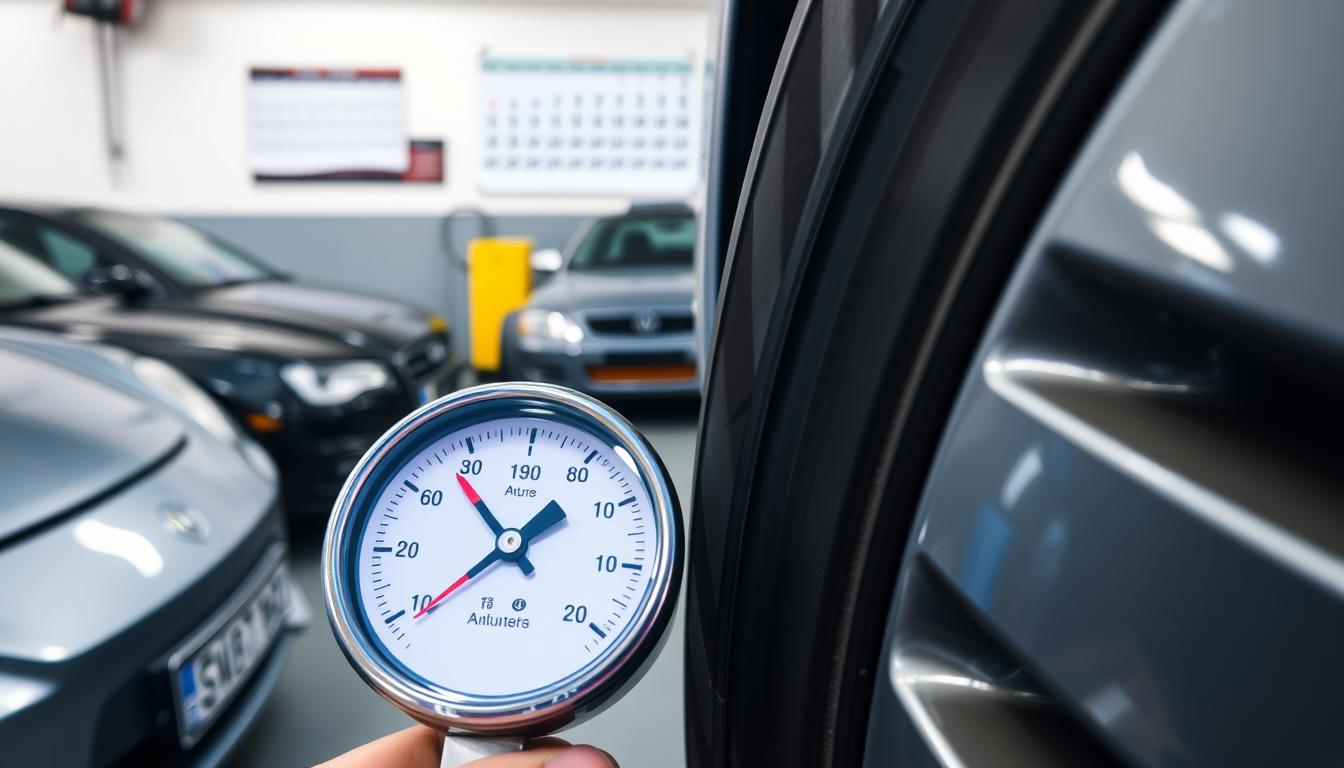Checking your tire pressure is key for safety and car performance. So, how often should you do it? Experts say at least once a month, but better every other week. This habit helps avoid blowouts, makes driving easier, and saves fuel.
Winter temperatures can drop pressure a lot. So, checking often is a must for all car owners.
Key Takeaways
- Check tire pressure at least once a month; ideally every other week.
- Cold temperatures can lower tire pressure significantly.
- Maintaining proper tire pressure enhances vehicle safety and performance.
- Improperly inflated tires can lead to increased wear and reduced lifespan.
- Regular checks can prevent stranding due to flat tires.
Understanding Tire Pressure Basics
Tire pressure is the air in a tire, measured in pounds per square inch (PSI). Knowing about tire pressure is key for safe driving. It helps with safety, fuel use, and tire life. Always check tire pressure to avoid problems.
What is Tire Pressure?
Tire pressure shows how much air is in a tire. It’s important for your car’s performance. Tires lose about 1 PSI each month.
Temperature changes can also affect pressure. For every 10-degree change, pressure changes by 1 PSI.
Why Tire Pressure Matters
Tire pressure is very important. The right pressure makes your car more fuel-efficient. It also makes your tires last longer.
Under-inflated tires wear out faster and can blow out. Over-inflation damages the center of the tire. Most cars need between 30 to 35 PSI.
Effects of Low Tire Pressure
Low tire pressure causes many problems. It can lead to blowouts and poor handling. It also makes your car use more fuel.
Check tire pressure monthly. Use cold tires for accurate readings. Regular checks keep you safe on the road.
| Condition | Impact | Recommended Action |
|---|---|---|
| Under-Inflation | Increased wear on edges, risk of blowouts | Check and inflate tires to specified PSI |
| Over-Inflation | Uneven tread wear, harsher ride | Release air to align with manufacturer recommendations |
| Correct Inflation | Improved fuel economy, optimized handling | Maintain pressure according to specifications |
| Temperature Change | Pressure fluctuation, potential loss | Adjust pressure when temperatures change significantly |
Ideal Tire Pressure Levels
Keeping the right tire pressure is key for your car’s performance and safety. The ideal pressure varies by vehicle. So, it’s important to know how to find your car’s recommended PSI levels.
Finding Your Vehicle’s Recommended PSI
Most cars need tire pressure between 28 to 36 PSI for daily driving. To find your car’s specific PSI, look in the owner’s manual or on the driver’s door sticker. Driving on underinflated tires can shorten tire life by 15% and raise fuel costs a lot.
How to Adjust Tire Pressure
Changing tire pressure is easy. Use a good tire pressure gauge, which costs $10 to $20, to check your PSI. If your tires are low, add air until they reach the recommended PSI.
If they’re too high, let some air out to match the ideal pressure. Tire pressure can go up by 2-6 PSI after driving. It can also drop in cold weather. Keeping tire pressure right improves traction, saves gas, and makes tires last longer.
When to Check Tire Pressure
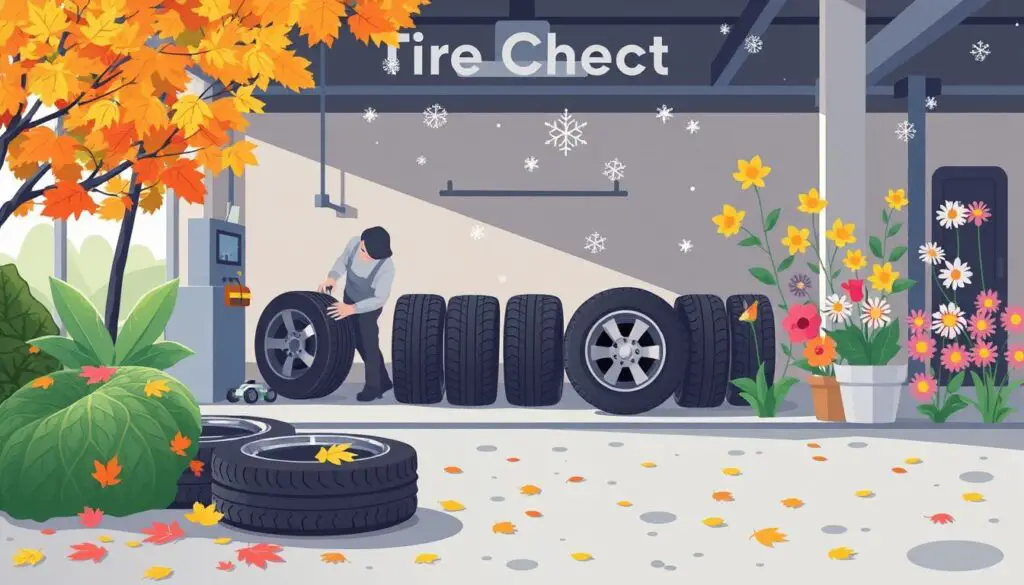
Keeping the right tire pressure is key for safe driving and good car performance. Regular checks can spot problems early. Knowing when to check tire pressure helps keep you safe and efficient.
Seasonal Considerations
Seasonal changes affect tire pressure. In cold months, tire pressure drops by about one pound per square inch for every ten-degree drop. This makes a seasonal tire check vital to avoid under-inflation. In winter, often check tire pressure to keep your car stable on icy roads.
Before Long Trips
Correct tire pressure before long trips is a must for safety. Checking tire pressure before a long drive can prevent tire failures. This simple step makes your trip safer and more fun.
Monthly Maintenance Routine
Having a monthly tire maintenance routine is smart. Check tires at least once a month to catch issues early. Properly inflated tires are safer and save fuel, making it a wise habit for all drivers.
Tools for Measuring Tire Pressure
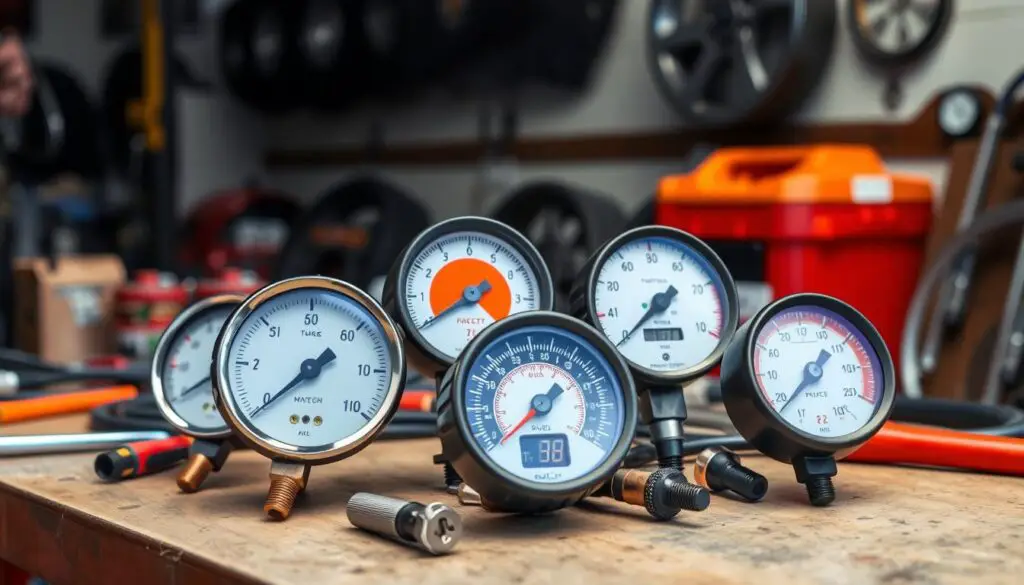
Knowing the tools for measuring tire pressure is key to keeping your tires in top shape. There are many types of gauges to choose from. The right one can make your car safer and run better.
Types of Tire Pressure Gauges
There are many kinds of tire pressure gauges, each with its own benefits:
- Digital Gauges: These are known for their accuracy and easy-to-read screens. Brands like Tekton and Accutire are top choices for precise readings.
- Analog Gauges: These are tough and show pressure on a dial. They might not have all the features of digital ones, but they’re reliable.
- Portable Air Compressors: You can find these at auto parts stores. They use your car’s battery or 12V port. They cost about $0.50 or $1.00 to use, making inflation easy anywhere.
Digital Gauges vs. Analog Gauges
When deciding between digital and analog gauges, think about how accurate and easy they are to use:
| Feature | Digital Gauges | Analog Gauges |
|---|---|---|
| Accuracy | High | Moderate |
| Ease of Reading | Very Easy | Moderate |
| Durability | Moderate | High |
| Price Range | $10 – $30 | $5 – $20 |
Using a good gauge to check tire pressure often can help avoid problems. It can prevent tire wear and save fuel. Always check your tire pressure monthly and before long trips.
Signs Your Tire Pressure Needs Attention
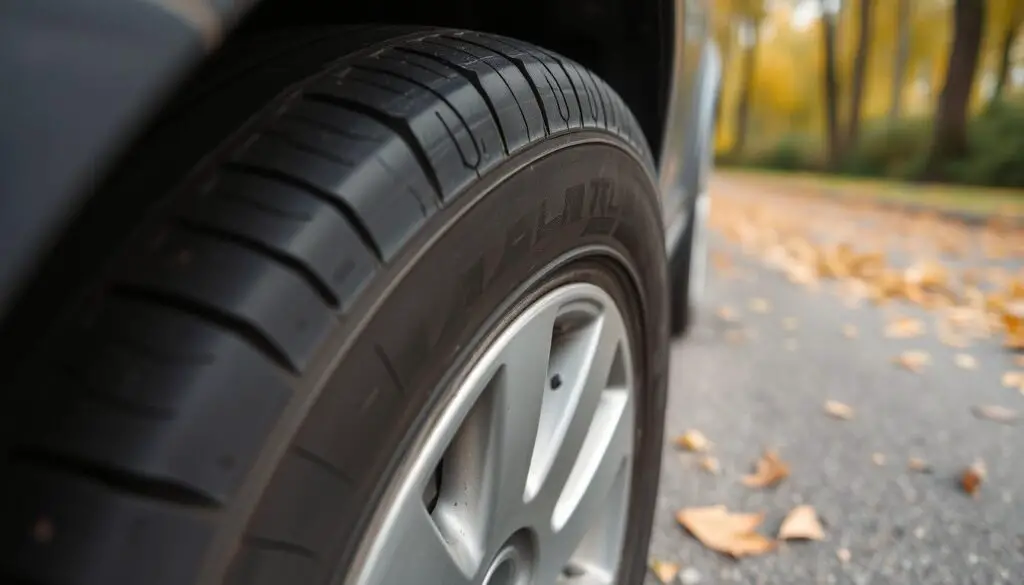
Knowing when your tire pressure is low is key to keeping your car safe and running well. Low pressure shows up in ways you can see and feel. Spotting these signs early can help avoid bigger problems later.
Visual Signs of Low Pressure
Finding out if your tire pressure is low is easy. Just look for these signs:
- Flat tires: A flat tire is the clearest sign.
- Uneven tire wear: Look for wear patterns that show the tire wasn’t inflated right.
- Tire bulging: Bulges or changes in shape mean the tire isn’t full of air.
Handling Changes and Tire Pressure
Changes in how your car handles can also mean low tire pressure. A drop in pressure can cause:
- Instability: Tires with too little air don’t grip the road well.
- Longer braking distances: Low air makes stopping harder, which is dangerous.
- Reduced responsiveness: If your car feels slow to turn or steer, it might be a tire issue.
Fixing these problems quickly makes driving safer and more comfortable. Regular checks can stop these issues before they get worse.
The Importance of Warm Tire Readings
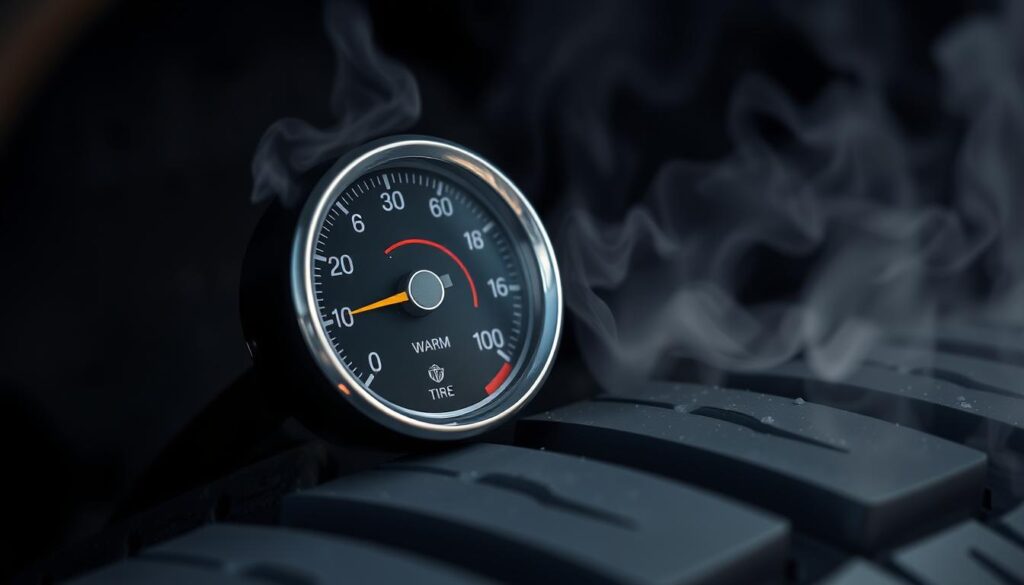
It’s key to know how heat and tire pressure are linked for the best tire performance. Tires get hot when moving, which changes their pressure. This knowledge helps avoid dangers from wrong tire pressures.
Understanding Tire Heating
Tires get hot from friction while driving. This heat makes the air inside the tires warmer, raising the pressure. To get accurate readings, wait at least three hours after driving to check the pressure.
How Temperature Affects Pressure
Temperature and tire pressure are closely related. A 10-degree change in temperature can raise or lower tire pressure by about 2%. Warmer days mean higher readings, while cold days mean lower ones. It’s smart to check tire pressure often and adjust for the season.
| Temperature Change (°F) | Pound per Square Inch Change (PSI) |
|---|---|
| 10 | 2 |
| 30 | 6 |
| 60 | 12 |
Knowing about warm tire readings and temperature changes is crucial. Checking tire pressure often helps understand how temperature affects safety and performance.
Checking Tire Pressure: Best Practices
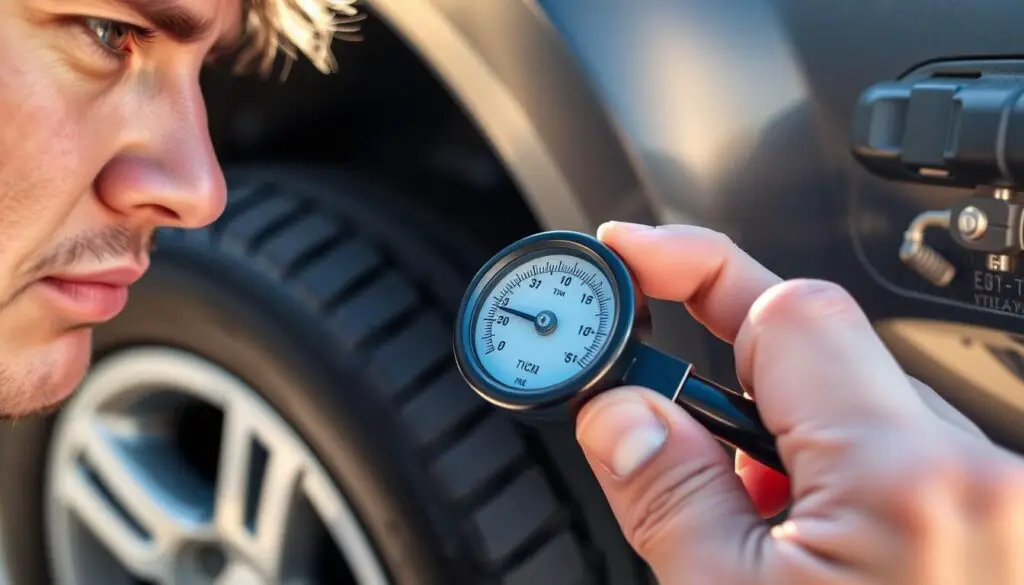
Keeping the right tire pressure is key for safety and performance. Following best practices for measuring tire pressure helps your vehicle run well. Here are steps and tips for accurate readings.
Steps for Proper Tire Pressure Measurement
- Make sure tires are cold before checking, best after parking for a few hours.
- Take off the valve caps from the tires.
- Put the tire pressure gauge on the valve stem and press until you hear a hiss.
- Look at the pressure on the gauge and write it down.
- Do this a few times to make sure the reading is the same.
Keeping Your Gauge Accurate
It’s important to calibrate your tire gauge for accurate readings. Here are some tips:
- Check the calibration by comparing it with another good gauge often.
- Get a gauge that fits your car’s needs, as tire pressures vary.
- Look at the car maker’s recommended PSI, usually between 28 and 36 PSI for most cars.
Following these steps helps drivers stay safe, save on fuel, and make tires last longer. Accurate tire gauge readings improve your car’s performance, making driving smoother.
Safety Risks of Ignoring Tire Pressure
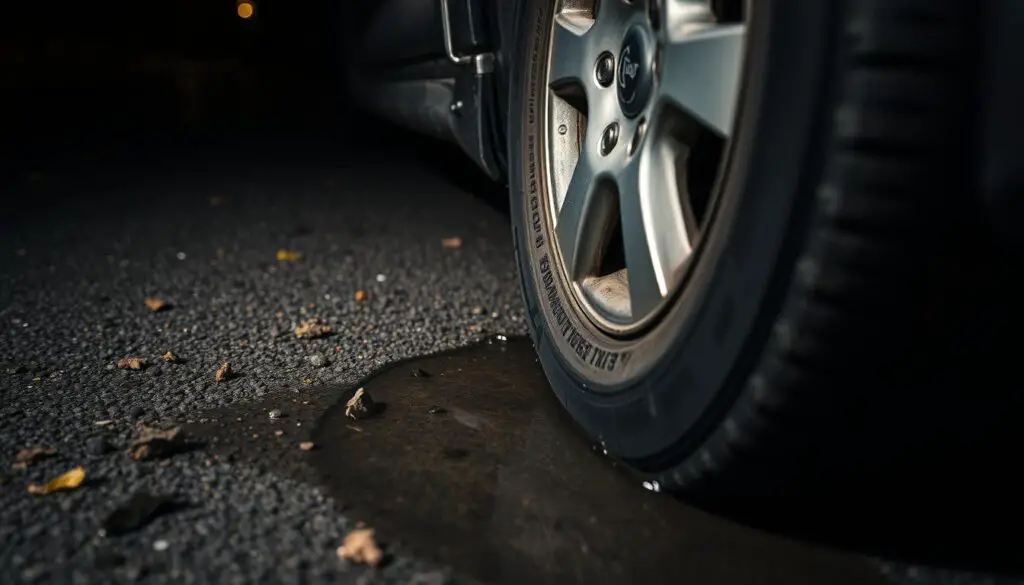
Keeping the right tire pressure is key for safe driving. Not checking tire pressure can cause big safety problems. This includes blowouts and handling issues that can harm the driver and others.
Increased Risk of Blowouts
Under-inflated tires get too hot, making blowouts more likely. If a tire is 25% or more under the recommended pressure, the TPMS alerts the driver. Ignoring this warning can cause serious problems, like losing control of the vehicle at high speeds.
Effects on Handling and Stopping
Low tire pressure makes driving harder and braking slower. Drivers might find steering and stopping tough. This is worse in emergencies.
It also makes stopping on wet or slippery roads harder. Not checking tire pressure can also wear out tires faster. This means you’ll need to replace them more often, costing more money.
| Risk Factors | Consequences |
|---|---|
| Low Tire Pressure | Increased rolling resistance and decreased fuel efficiency |
| Blowouts at high speeds | Loss of vehicle control and severe accidents |
| Sluggish handling | Longer braking distances and reduced stability |
| Improperly inflated tires | Uneven tread wear and premature tire replacements |
Environmental Impact of Tire Pressure

Keeping your tires at the right pressure is key for safety and the planet. Many drivers don’t know that low tire pressure means more fuel use. This hurts the environment.
Under-inflated tires make your car use more fuel. This is because they have higher rolling resistance. This means your car gets less miles per gallon.
Fuel Efficiency Considerations
Driving with the right tire pressure can save you about 3.3 percent on gas. If your tire pressure is off by just one PSI, you’ll use 0.4 percent more fuel. This adds up fast.
For example, someone driving 12,000 miles a year with low tire pressure wastes 144 extra gallons of gas. This costs between $300 to $500 each year. It also means more carbon dioxide in the air, since each gallon of gas adds about 20 pounds of carbon dioxide.
Tire Lifespan and Eco-friendliness
Looking after your tires is good for the planet. Tires at the right pressure can last 30-50% longer than those that are not. This means fewer tires need to be thrown away.
In the U.S., under-inflated cars can dump an extra 14 million tires each year. With so many cars on the road, keeping tires inflated is very important. It helps the environment a lot.
The Connection Between Tire Pressure and Fuel Economy
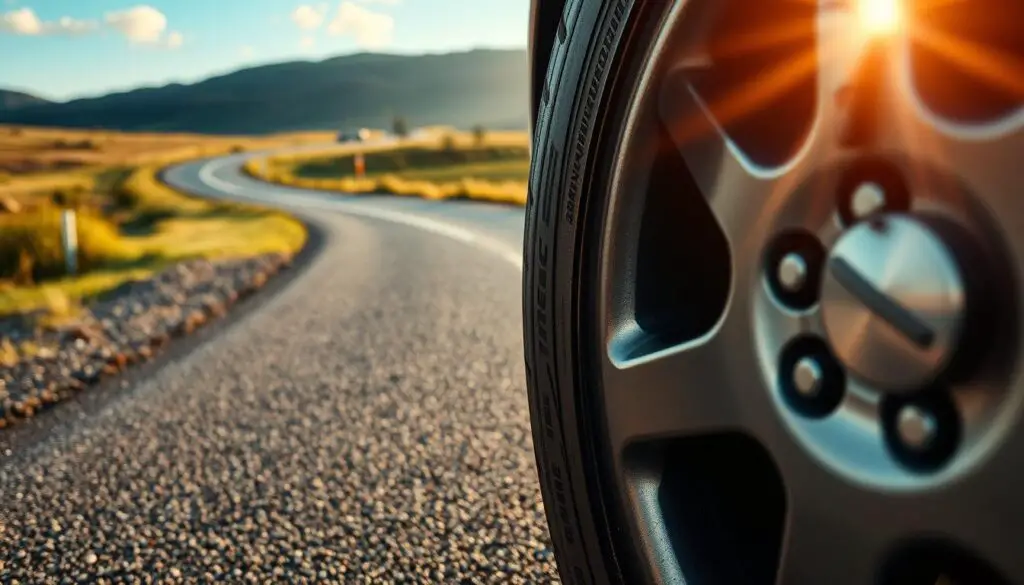
Keeping your tires at the right pressure is key for better gas mileage and car performance. Properly inflated tires can make your car go further on a tank of gas. This can save you money on gas costs.
How Tire Pressure Affects Gas Mileage
The U.S. Department of Energy says you can get up to 3% better gas mileage with the right tire pressure. This can save a lot of money. For example, at $4.00 per gallon, you could save $2.40 every time you fill up.
Over a year, if you fill up weekly, you could save almost $125. Tires lose about 1 PSI of pressure each month. Losing just 1 PSI can cut your fuel efficiency by half a percent.
Seasonal changes can also affect your tire pressure. A 50°F drop in temperature can cause a 5 to 10 PSI loss. So, it’s important to check your tire pressure often.
Best Practices for Fuel Efficiency
Here are some tips to help you save money and keep your car safe:
- Check tire pressure regularly, before long trips or when the seasons change.
- Make sure tires are at the recommended PSI from the manufacturer.
- Rotate tires every six months to keep tread even.
- Look for uneven wear that might mean your car is not aligned right.
- Use the penny test to check tread depth. If Lincoln’s head is not covered, it’s time for new tires.
Proper tire pressure not only saves gas but also makes your tires last longer. It also makes your car handle better. This makes driving more fun.
Monitoring Tire Pressure with Technology
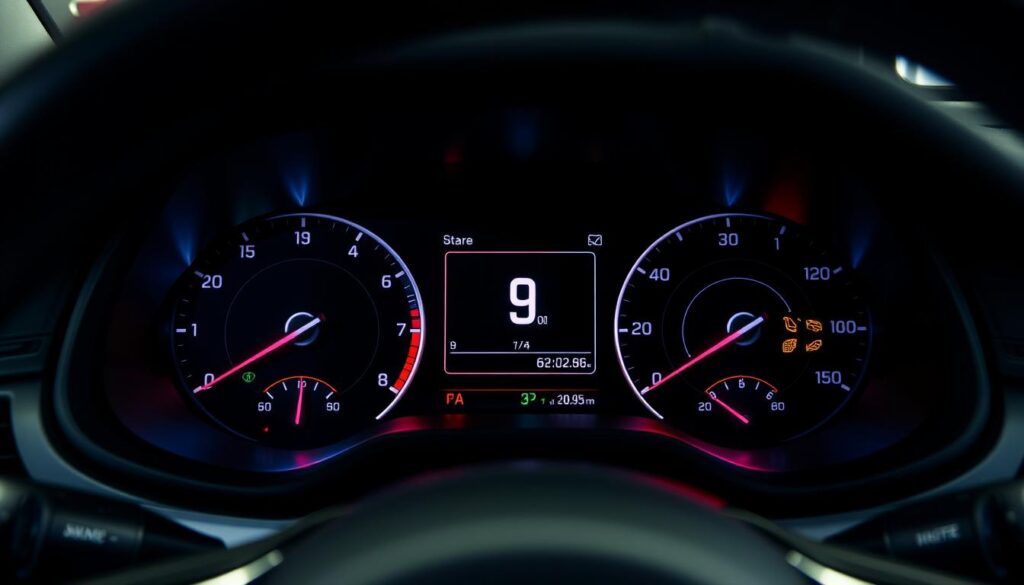
Today, technology is key for safe and efficient tires. Since 2007, all new cars must have tire pressure monitoring systems (TPMS). These systems warn drivers about under- or over-inflated tires, avoiding dangers.
Tire Pressure Monitoring Systems (TPMS)
TPMS gives drivers real-time tire pressure info. If pressure is too low, a light on the dashboard tells you. This helps keep tires at the right pressure.
Right tire pressure can save money on gas. It can also make your tires last longer, up to 4,700 miles.
Smartphone Apps for Tire Maintenance
There are also apps to help with tire care. These apps remind you to check tire pressure and give tips for keeping tires in good shape. They work with TPMS to keep your tires just right.
Using these apps helps keep your car safe and running well. It’s a smart way to take care of your tires.
| Feature | TPMS | Tire Maintenance Apps |
|---|---|---|
| Alerts on Low Pressure | Yes | No |
| Fuel Savings Potential | Up to $0.11 per gallon | Varies by user maintenance |
| Maintenance Reminders | No | Yes |
| Average Lifespan | 5-10 years | Ongoing, app-dependent |
| Overall Tire Health Monitoring | Limited to pressure | Comprehensive |
Reviewing Tire Pressure Regularly
It’s key to have a tire maintenance schedule for your car’s safety and performance. Check tire pressure at least once a month, as car experts suggest. This helps spot any changes and keeps tires at the right pressure.
Also, check tire pressure before long trips. It makes driving safer and better.
Creating a Tire Maintenance Schedule
Using a digital tire gauge, which costs about $12, makes checking easier. A regular check routine stops problems from low or high pressure. Tires lose about one PSI each month, so checking often is crucial.
Benefits of Consistent Monitoring
Regular tire checks improve fuel use and road safety. Tire pressure changes with temperature, so watching it is important. It prevents longer stops and better car response.
Keeping tire pressure up saves money on new tires. It also makes driving smoother and safer.
FAQ
How often should I check my tire pressure?
What is the ideal tire pressure for my vehicle?
Why does tire pressure fluctuate with the seasons?
What tools do I need to measure tire pressure accurately?
How can I tell if my tires are underinflated?
When is the best time to check tire pressure?
What are the risks of ignoring low tire pressure?
How does maintaining proper tire pressure affect fuel efficiency?
Are there technologies to help monitor tire pressure?
How can I create a tire maintenance schedule?

Jack Thompson is a writer and seasoned auto mechanic with over 15 years of experience in the automotive industry. Known for his expertise in vehicle mechanics, Jack has a deep understanding of car and truck systems. His skills, honed through years of hands-on experience, have made him a trusted name in the field. Jack is committed to providing valuable insights into car maintenance and repair, helping vehicle owners keep their vehicles in top condition.

